Aaron Von Frankenstein
I’ve seen plenty of blog posts lately about Aaron. What Aaron did. How What Aaron Did is not much different from “what we do” every day, where “we” refers to tech-savvy Internet users. Aaron was accused. Aaron was indicted. Aaron was attacked by the powers that be, captured, cornered, labeled a criminal and sentenced to […]
Comparing Desktop vs Mobile Usage
With so much interest and buzz around mobile and its impact on search, this recent study by the Harris Poll was telling and helpful from an SEO and link building standpoint.
Harris asked smartphone users about their habits and which appliance they used when performing certain online tasks like reading email and researching goods. They polled 2400 adults, 991 of whom use a smartphone. Here are a handful of interesting results from the survey with potential to influence SEO:
|
Uses a computer (desktop/laptop) % |
Uses a smartphone % |
||
|
|
|
|
|
|
Take surveys |
86% |
Take surveys |
24% |
|
Research good or services |
81% |
Research goods and services |
45% |
|
|
|
|
|
|
Read work emails |
59% |
Read work emails |
38% |
|
Send work emails |
60% |
Send work emails |
32% |
|
|
|
|
|
|
Read social media on sites/apps such as Facebook & Twitter |
62% |
Read social media on sites/apps such as Facebook & Twitter |
56% |
|
Share social media |
51% |
Share social media |
44% |
Research/Surveys
The fact 81% of the people polled use a computer to research or take a survey isn’t surprising, both tasks are easier from a visual and aesthetics view when done on a large screen. But… 45% mobile users is not a number to dismiss. Both numbers reinforce a number of SEO points:
- Keep your visual and written content separate so anyone using a smartphone can easily click to what they want to find. Good case for building a presence on Pinterest or Flickr if you have a lot of visual products.
- Keep producing descriptive, informative and up-to-date content for your website. (Don’t send it away!) Promote what you write through social media, email distribution lists and on your blogs, forums, etc.
- Use a “social media” type press release when announcing new products and major content additions to your site.
- For affiliate marketers: A growing number of shoppers use bricks and mortar stores as “showrooms” before going back online to make a purchase. Keep your best promotions and discounts on your site rather than on sites like Coupon Cabin. Create an app to alert people when new products and discounts are available.
- Add RSS sign up options on all pages especially those with content and discounts.
- Promote new content through an app as well!
Read/Send eMail
If you use email in any way to build links, know more people use computers to read and send work email than mobile devices.
- If you are contacting people for content or link placement and doing it after business hours, know more people will see your message on their smartphones. Keep the email short and to the point, if you need to use images link out rather than embed.
- Keep in mind most people using smartphones do so when they are on the move or after business hours. Either scenario means you need to hook their attention the second he/she opens the email. Work hard to make subject lines pop and state your mission in the first sentence or two.
Social Media
Based on the percentages shown here, people like their social media no matter what device they are on!
- Include social media share elements on everything you publish (even PDF’s)
- Create a Google Plus account and establish authorship
- Use niche social media sites as well as the big boys
- Mix up the type of content you use, create contests for Twitter and polls on Facebook
Final Tip:
Although this wasn’t included in the Harris Poll, the fact people are using their smartphone 45% of the time to research goods and services warrants a mention: add a click-to-call option and/or telephone number on all your mobile pages as well as links to your full website and email.
The full version of this post can be found in our SEOBook forum.
Does Your Company Have A Harlem Shake Video?
By far one of the most interesting examples of brands using social media trends to show off company culture is the recent “Harlem Shake” videos being passed around.
It all started with a few teenagers from the Filthy Frank YouTube channel making a dance video of Baauer’s Harlem Shake song on February 2nd, 2013. Here’s the video (brace yourself).
http://www.youtube.com/watch?v=8vJiSSAMNWw
Within hours, a few other Youtube channels (
Does Your Company Have A Harlem Shake Video? is a post from: Point Blank SEO
How to Consistently Build 40+ Contextual Links Every Month
 A contextual link is a type of link that’s usually found within the body of content and is in context with the idea surrounding the link. It can be both natural (voluntary links from other websites – ex: link bait) and artificial (manually built – ex: one of your guest posts that links back to your blog/content).
A contextual link is a type of link that’s usually found within the body of content and is in context with the idea surrounding the link. It can be both natural (voluntary links from other websites – ex: link bait) and artificial (manually built – ex: one of your guest posts that links back to your blog/content).
Acquiring links is a vital process in online marketing, as the practice benefits a site in so many ways, such as in building online brand presence, driving targeted traffic/leads and in getting better search ranking positions.
Yelp’s Biggest Threat
Taylor Hatmaker on Yelp’s Q4 loss of $5.3 million: Yelp should own local. But it doesn’t. The company, founded in the mobile dark age of 2004, is being assaulted on some major fronts. There’s Foursquare of course, but the biggest threat is Facebook’s renewed interest in local, which the company will be building out […]
The post Yelp’s Biggest Threat appeared first on Local SEO Guide.
The Content Outreach Pyramid: How to Get in Front of Your Targets
This is a guest post by Matthew Barby at Wow Internet.
Outreach seems to be the buzzword of 2013 and I have read numerous articles over the past couple of months on “how to find guest blogging opportunities” and “the best ways to contact your outreach targets”. What I want to talk about is a model of outreach that we have been working with at Wow Internet that I call ‘The Content Outreach Pyramid’.
The purpose of …
The Content Outreach Pyramid: How to Get in Front of Your Targets is a post from: Point Blank SEO
No Effort Longtail SEO Revenues, from FindTheBest
In our infographic about the sausage factory that is online journalism, we had a throw away line about how companies were partnering with FindTheBest to auto-generate subdomains full of recycled content. Apparently, a person named Brandon who claims to work for FindTheBest didn’t think our information was accurate:
Hi Aaron,
My name is Brandon. I have been with FindTheBest since 2010 (right after our launch), and I am really bummed you posted this Infographic without reaching out to our team. We don’t scrape data. We have a 40 person+ product team that works very closely with manufacturers, companies, and professionals to create useful information in a free and fair playing field. We some times use whole government databases, but it takes hundreds-of-thousands of hours to produce this content. We have a product manager that owns up to all the content in their vertical and takes the creation and maintenance very seriously. If you have any questions for them about how a piece of content was created, you should go to our team page and shoot them a email. Users can edit almost any listing, and we spend a ton of time approving or rejecting those edits. We do work with large publishers (something I am really proud of), but we certainly do not publish the same exact content. We allow the publishers to customize and edit the data presentation (look, style, feel) but since the majority of the content we produce is the factual data, it probably does look a little similar. Should we change the data? Should we not share our awesome content with as many users as possible? Not sure I can trust the rest of your “facts”, but great graphics!
I thought it was only fair that we aired his view on the main blog.
…but then that got me into doing a bit of research about FindTheBest…
In the past when searching for an issue related to our TV I saw a SERP that looked like this

Those mashed sites were subdomains on trusted sites like VentureBeat & TechCrunch.
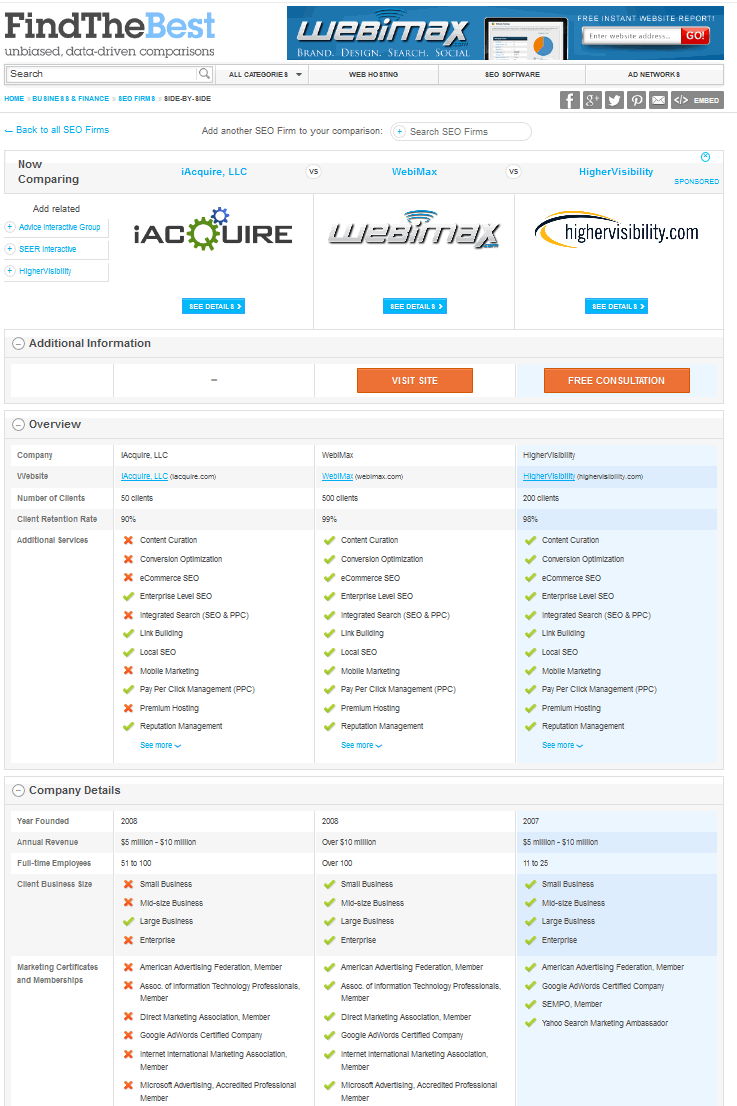
Graphically the comparison pages appear appealing, but how strong is the editorial?
How does Find The Best describe their offering?
In a VentureBeat post (a FindTheBest content syndication partner) FTB’s CEO Kevin O’Connor was quoted as saying: “‘Human’ is dirty — it’s not scalable.”
Hmm. Is that a counter view to the above claimed 40 person editorial research team? Let’s dig in.
Looking at the top listed categories on the homepage of Find The best I counted 497 different verticals. So at 40 people on the editorial team that would mean that each person managed a dozen different verticals (if one doesn’t count all the outreach and partnership buildings as part of editorial & one ignores the parallel sites for death records, grave locations, find the coupons, find the company & find the listing).

Google shows that they have indexed 35,000,000 pages from FindTheBest.com, so this would mean each employee has “curated” about 800,000 pages (which is at least 200,000 pages a year over the past 4 years). Assuming they work 200 days a year that means they ensure curation of at least 1,000 “high quality” pages per day (and this is just the stuff in Google’s index on the main site…not including the stuff that is yet to be indexed, stuff indexed on 3rd party websites, or stuff indexed on FindTheCompanies.com, FindTheCoupons.com, FindTheListing, FindTheBest.es, FindTheBest.or.kr, or the death records or grave location sites).








Maybe I am still wrong to consider it a bulk scrape job. After all, it is not unreasonable to expect that a single person can edit 5,000 pages of high quality content daily.
Errr….then again…how many pages can you edit in a day?
Where they lost me though was with the “facts” angle. Speaking of not trusting the rest of “facts” … how crappy is the business information for SEO Book on FindTheBest that mentions that our site launched in 2011, we have $58,000 in sales, and we are a book wholesaler.
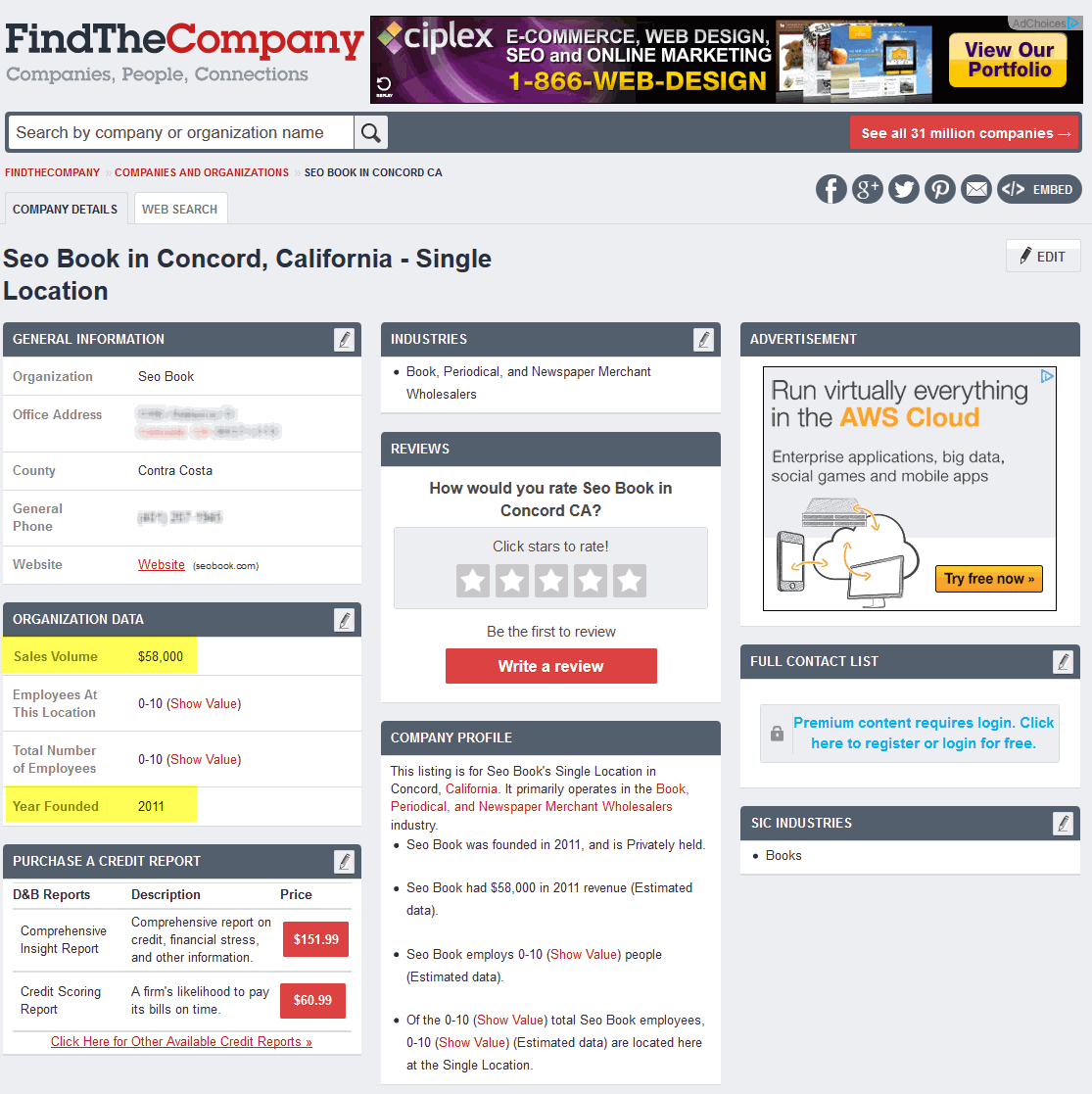
I realize I am afforded the opportunity to work for free to fix the errors of the scrape job, but if a page is full of automated incorrect trash then maybe it shouldn’t exist in the first place.
I am not saying that all pages on these sites are trash (some may be genuinely helpful), but I know if I automated content to the extent FTB does & then mass email other sites for syndication partnerships on the duplicate content (often full of incorrect information) that Google would have burned it to the ground already. They likely benefit from their CEO having sold DoubleClick to Google in the past & are exempt from the guidelines & editorial discrimination that the independent webmaster must deal with.
One of the ways you can tell if a company really cares about their product is by seeing if they dogfood it themselves.
Out of curiousity, I looked up FindTheBest on their FindTheCompany site.

They double-list themselves and neither profile is filled out.
That is like having 2 sentence of text on your “about us” page surrounded by 3 AdSense blocks. :D
I think they should worry about fixing the grotesque errors before worrying about “sharing with as many people as possible” but maybe I am just old fashioned.
Certainly they took a different approach … one that I am sure that would get me burned if I tried it. An example sampling of some partner sites…
- accountants.entrepreneur.com
- acronyms.sciencedaily.com
- alternative-fuel.cleantechnica.com
- analytics-software.businessknowhow.com
- antivirus.betanews.com
- apps.edudemic.com
- atvs.agriculture.com
- autopedia.com/TireSchool/
- autos.nydailynews.com
- backup-software.venturebeat.com
- bags.golfdigest.com
- beer.womenshealthmag.com
- best-run-states.247wallst.com
- bestcolleges.collegenews.com
- bikes.cxmagazine.com
- bikes.triathlete.com
- birds.findthelisting.com
- birth-control.shape.com
- brands.goodguide.com
- breast-pumps.parenting.com
- broker-dealers.minyanville.com
- businessschools.college-scholarships.com
- camcorders.techcrunch.com
- cars.pricequotes.com
- cats.petharbor.com
- catskiing.tetongravity.com
- chemical-elements.sciencedaily.com
- comets-astroids.sciencedaily.com
- companies.findthecompany.com
- companies.goodguide.com
- compare-video-editing-software.burnworld.com
- compare.consumerbell.com
- compare.guns.com
- compare.roadcyclinguk.com
- comparemotorbikes.motorbike-search-engine.co.uk
- congressional-lookup.nationaljournal.com
- courses.golfdigest.com
- crm.venturebeat.com
- cyclocross-bikes.cyclingdirt.org
- dealers.gundigest.com
- death-record.com
- debt.humanevents.com
- design-software.underworldmagazines.com
- destination-finder.fishtrack.com
- diet-programs.shape.com
- digital-cameras.techcrunch.com
- dinosaurs.sciencedaily.com
- dirt-bikes.cycleworld.com
- dogbreeds.petmd.com
- dogs.petharbor.com
- donors.csmonitor.com
- e-readers.techcrunch.com
- earmarks.humanevents.com
- earthquakes.sciencedaily.com
- ehr-software.technewsworld.com
- fallacies.sciencedaily.com
- fec-candidates.theblaze.com
- fec-committees.theblaze.com
- federal-debt.nationaljournal.com
- fha-condos.realtor.org
- fha.nuwireinvestor.com
- financial-advisors.minyanville.com
- findthebest.com
- findthebest.motorcycleshows.com
- findthecoupons.com
- findthedata.com
- firms.privateequity.com
- franchises.fastfood.com
- ftb.cebotics.com
- game-consoles.tecca.com
- game-consoles.venturebeat.com
- gin.drinkhacker.com
- golf-courses.bunkershot.com
- gps-navigation.techcrunch.com
- gps-navigation.venturebeat.com
- green-cars.cleantechnica.com
- guns.dailycaller.com
- ham-radio.radiotower.com
- hdtv.techcrunch.com
- hdtv.venturebeat.com
- headphones.techcrunch.com
- headphones.venturebeat.com
- high-chairs.parenting.com
- highest-mountains.sciencedaily.com
- hiv-stats.realclearworld.com
- horsebreeds.petmd.com
- hospital-ratings.lifescript.com
- hr-jobs.findthelistings.com
- inventors.sciencedaily.com
- investment-advisors.minyanville.com
- investment-banks.minyanville.com
- iv-housing.dailynexus.com
- laptops.mobiletechreview.com
- laptops.techcrunch.com
- laptops.venturebeat.com
- lawschool.lawschoolexpert.com
- locategrave.org
- mammography-screening-centers.lifescript.com
- mba-programs.dealbreaker.com
- medigap-policies.findthedata.org
- military-branches.nationaljournal.com
- motorcycles.cycleworld.com
- mountain-bikes.outsideonline.com
- nannies.com
- nobel-prize-winners.sciencedaily.com
- nursing-homes.caregiverlist.com
- nursing-homes.silvercensus.com
- onlinecolleges.collegenews.com
- phones.androidauthority.com
- pickups.agriculture.com
- planets.realclearscience.com
- planets.sciencedaily.com
- plants.backyardgardener.com
- presidential-candidates.theblaze.com
- presidents.nationaljournal.com
- privateschools.parentinginformed.com
- processors.betanews.com
- project-management-software.venturebeat.com
- projectors.techcrunch.com
- pushcarts.golfdigest.com
- recovery-and-reinvestment-act.theblaze.com
- religions.theblaze.com
- reviews.creditcardadvice.com
- saving-accounts.bankingadvice.com
- sb-marinas.noozhawk.com
- sb-nonprofits.noozhawk.com
- scheduling-software.venturebeat.com
- scholarships.savingforcollege.com
- schools.nycprivateschoolsblog.com
- scooters.cycleworld.com
- smartphones.techcrunch.com
- smartphones.venturebeat.com
- solarpanels.motherearthnews.com
- sports-drinks.flotrack.org
- stables.thehorse.com
- state-economic-facts.nationaljournal.com
- steppers.shape.com
- strollers.parenting.com
- supplements.womenshealthmag.com
- tablets.androidauthority.com
- tablets.techcrunch.com
- tablets.venturebeat.com
- tabletsandstuff.com/tablet-comparison-chart
- tallest-buildings.sciencedaily.com
- technology.searchenginewatch.com
- telescopes.universetoday.com
- tequila.proof66.com
- texas-golf-courses.texasoutside.com
- tires.agriculture.com
- tractors.agriculture.com
- tsunamies.sciencedaily.com
- us-hurricanes.sciencedaily.com
- video-cameras.venturebeat.com
- volcanic-eruptions.com
- waterheaters.motherearthnews.com
- wetsuits.swellinfo.com
- whiskey.cocktailenthusiast.com
- whiskey.drinkoftheweek.com
- white-house-visitors.theblaze.com
- wineries.womenshealthmag.com
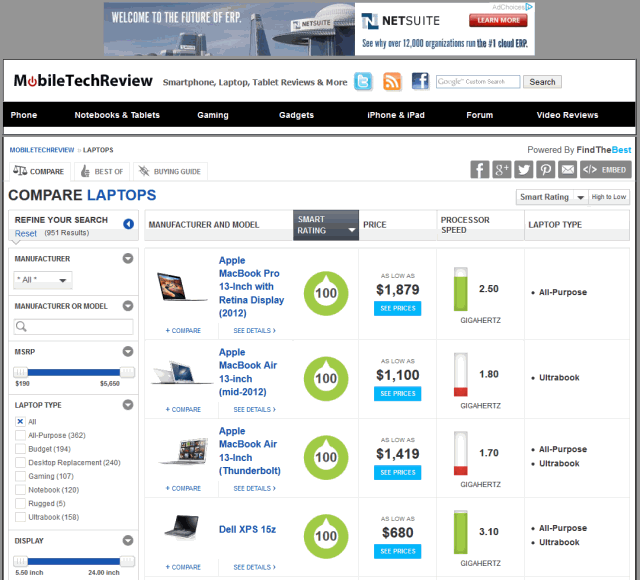
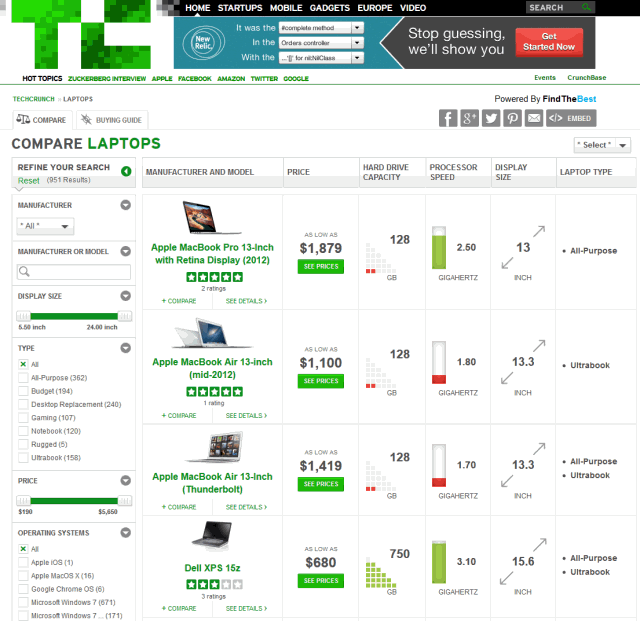
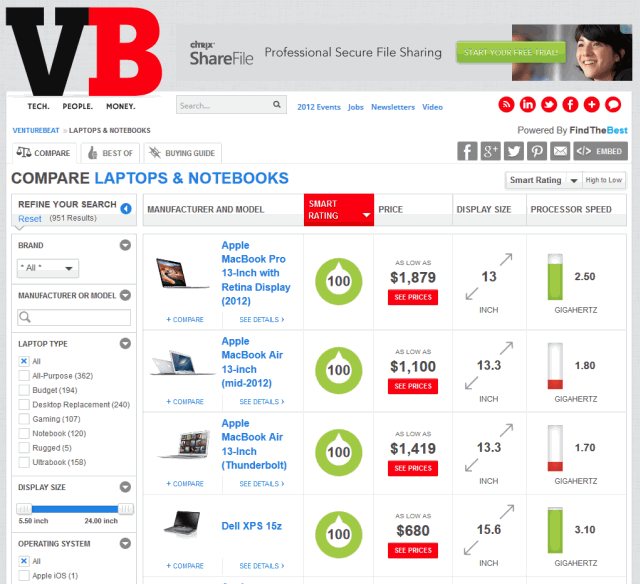
we have seen search results where a search engine didn’t robots.txt something out, or somebody takes a cookie cutter affiliate feed, they just warm it up and slap it out, there is no value add, there is no original content there and they say search results or some comparison shopping sites don’t put a lot of work into making it a useful site. They don’t add value. – Matt Cutts
That syndication partnership network also explains part of how FTB is able to get so many pages indexed by Google, as each of those syndication sources is linking back at FTB on (what I believe to be) every single page of the subdomains, and many of these subdomains are linked to from sitewide sidebar or footer links on the PR7 & PR8 tech blogs.
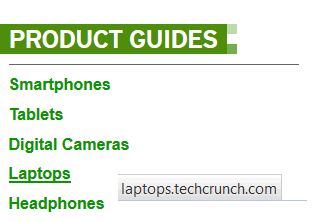
And so the PageRank shall flow ;)
Hundreds of thousands of hours (eg 200,000+) for 40 people is 5,000 hours per person. Considering that there are an average of 2,000 hours per work year, this would imply each employee spent 2.5 full years of work on this single aspect of the job. And that is if one ignores the (hundreds of?) millions of content pages on other sites.
How does TechCrunch describe the FTB partnership?
Here’s one reason to be excited: In its own small way, it combats the recent flood of crappy infographics. Most TechCrunch writers hate the infographics that show up in our inboxes— not because infographics have to be terrible, but because they’re often created by firms that are biased, have little expertise in the subject of the infographic, or both, so they pull random data from random sources to make their point.
Get that folks? TechCrunch hosting automated subdomains of syndicated content means less bad infographics. And more cat lives saved. Or something like that.
How does FTB describe this opportunity for publishers?
The gadget comparisons we built for TechCrunch are sticky and interactive resources comprised of thousands of SEO optimized pages. They help over 1 million visitors per month make informed decisions by providing accurate, clear and useful data.
SEO optimized pages? Hmm.
Your comparisons will include thousands of long-tail keywords and question/answer pages to ensure traffic is driven by a number of different search queries. Our proprietary Data Content Platform uses a mesh linking structure that maximizes the amount of pages indexed by search engines. Each month—mainly through organic search—our comparisons add millions of unique visitors to our partner’s websites.
Thousands of long-tail keyord & QnA pages? Mesh linking structure? Hmm.
If we expand the “view more” section at the footer of the page, what do we find?

Holy Batman.
Sorry that font is so small, the text needed reduced multiple sizes in order to fit on my extra large monitor, and then reduced again to fit the width of our blog.
Each listing in a comparison has a number of associated questions created around the data we collect.
For example, we collect data on the battery life of the Apple iPad.
An algorithm creates the question “How long does the Apple iPad tablet battery last?” and answers it
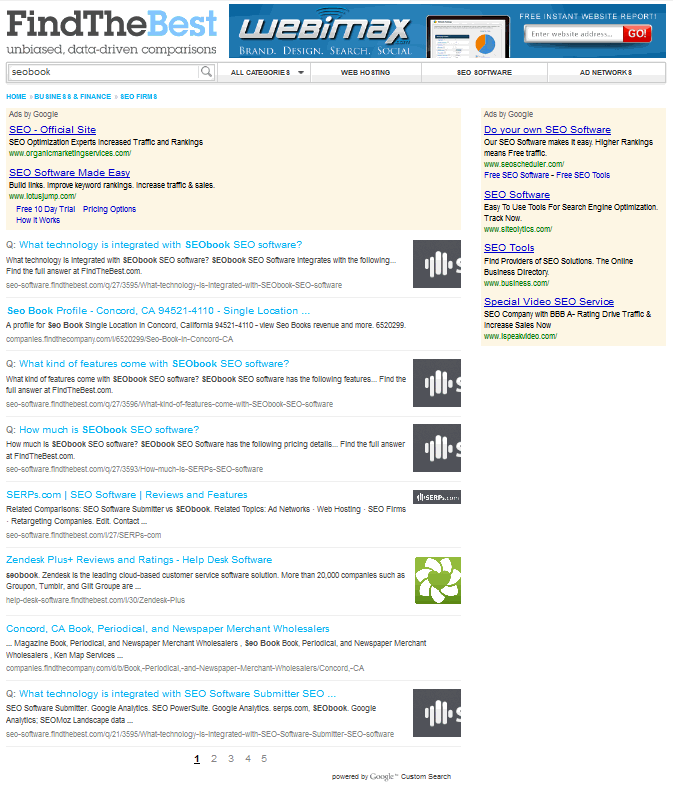
So now we have bots asking themselves questions that they answer themselves & then stuffing that in the index as content?
Yeah, sounds like human-driven editorial.
After all, it’s not like there are placeholder tokens on the auto-generated stuff

{parent_field}
Ooops.
Looks like I was wrong on that.
And automated “popular searches” pages? Nice!
As outrageous as the above is, they include undisclosed affiliate links in the content, and provided badge-based “awards” for things like the best casual dating sites, to help build links into their site.

That in turn led to them getting a bunch of porn backlinks.
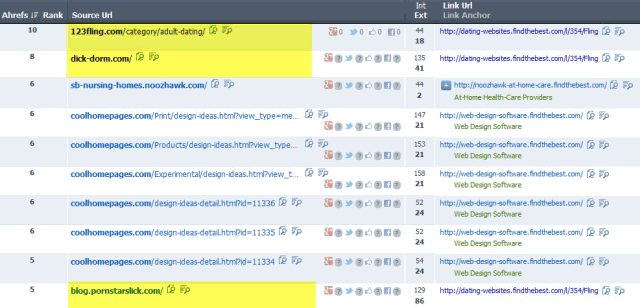
If you submit an article to an article directory and someone else picks it up & posts it to a sketchy site you are a link spammer responsible for the actions of a third party.
But if you rate the best casual dating sites and get spammy porn links you are wonderful.
Content farming never really goes away. It only becomes more corporate.
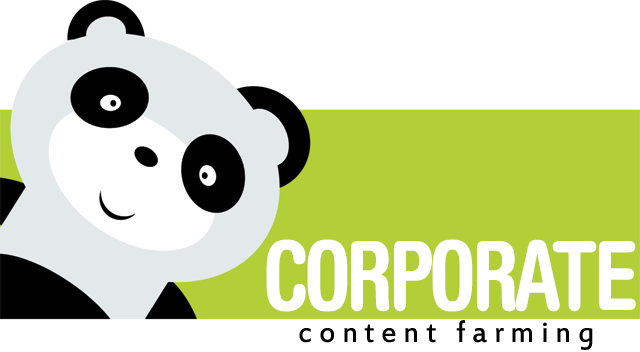
SEO isn’t dead, it’s merely evolving
I was until recently supposed to be speaking at this years LAC conference with a number of well respected SEO’s such as David Naylor, Nick Garner, Paul Reilly and Judith Lewis. I was fortunate enough to be asked to contribute to the IGB magazine as the topic as to whether or not SEO was dead […]
How To Write A Marketing Plan

A marketing plan is a document that outlines a set of actions necessary in order to meet specific objectives.
It’s one of those things many of us, especially those who have been doing search marketing for a while, probably keep largely in our heads. We know roughly where we’re going, the strategies needed to get there, and the objective is to get great rankings and increased traffic. So who needs to write it down?
Here’s a couple of good reasons.
Writing forces an analytic approach. The act of writing something down often brings about new ideas because it gets us out of the routine of “just doing”. Secondly, writing plans helps us write better proposals. A marketing plan is about both an analysis and a form of communication. It’s a means to get across your ideas to clients and other partners and convince them of the merits of what we’re doing.
If your clients are anything above small business level, then they likely already have formal marketing plans, of which search marketing is a part, so doing this sort of planning makes us better able to talk their language.
This post looks at the steps involved in writing a marketing plan, and how to optimize it so it will be most effective.
What Is A Marketing Plan?
A marketing plan:
- provides an analysis of the current situation
- lists goals
- outlines strategies, tactics and recommendations to achieve those goals
Above all, a marketing plan is a recommendation for a course of action.
How To Write A Marketing Plan
A marketing plan should cover the following topics:
- Summary & Recommendations
- Situation analysis
- Objectives
- Budget
- Strategy
- Execution
- Evaluation
The summary and recommendations outline the state of the market and your recommendations for achieving goals. The rest of your document supports these recommendations.
A situation analysis covers what is happening both inside and outside the company – the internal and external conditions. There are various methods of defining these conditions including SWOT analysis, Five Forces, and 5Cs. Whatever method you choose, they will include these three areas:
- The Customer
- The Competitors
- The Company
Customer: A company must serve the interests of the customer. What does the customer need?
Competitor: What do competitors offer? What are the points of difference between their company and yours? Do they serve the needs to the customer well? In what areas don’t they serve the needs of customers?
The Company – what makes sense in terms of existing resources? Could the company restructure to meet marketing goals? Could some product and service lines be switched?
A situation analysis is typically detailed and draws a picture of the state of play right now. It’s a list of known facts about internal and external forces.
The situation analysis is where you are now, the objectives are where you want to be and when. Objectives, as far as a business is concerned, are typically about the bottom line and increasing profitability.
Search marketers often think of micro-objectives in terms of rankings and positioning, but a question a client is much more interested in is how this ranking or positioning effort supports the macro-objective: greater profitability?
A high ranking might lead to more inquiries, and inquiries convert at X%, which are worth, on average, $X to the business. Once you link search marketing objectives to business objectives it’s a lot easier to sell search marketing and convince people of your strategies, particularly to decision makers.
Objectives such as convert x % more customers, get x more customers to landing page y, get x% more signups are all valid marketing goals as they are quantitative and therefore concrete. “Getting higher rankings” may be measurable, but it doesn’t, in itself, align with a business goal. If we can marry those two things together – rankings and higher profits – then search becomes an easy sell.
Traffic is another measurement we could use, or break it down further into types of traffic i.e. tightly targeted vs loosely targeted traffic. Whilst these facts may be difficult to pin down, this type of analysis helps people think about exactly how much each visitor is worth to them, and why. If each visitor has measurable value, then the value of search marketing plans are easy to prove, so long as the total search marketing spend is lower than the added value the visitors represent. One way to illustrate this potential is by using Google Adwords search volume data, or for a more accurate barometer – a trial PPC campaign run against desired keywords.
Budget: How much will the plan cost to execute? Once you can demonstrate the value of search traffic, then it becomes easier for a company to allocate budget.
Strategy: the nuts and bolts of how you will achieve your goals. In search marketing, this is typically split into two areas, PPC and SEO. A marketing plan typically doesn’t go into exact detail in terms of ranking and positioning technique. Keep it high level, else it’s likely to confuse, or people are likely to get bogged down in unnecessary detail.
Execution: Define who is responsible for what and when. Include milestones.
Evaluation: Evaluation is critical in that you need to establish if the plan is on target to meet goals, or has met goals. If not, then you may need to revise goals and strategy in order to get the plan back on track.
Planning often seems dry, but the very act of putting together a marketing plan will help give you fresh ideas, help clarify your approach, and makes it all easier to communicate with stakeholders.
One problem at this stage is that the marketing plan is likely to be a dull read. I’ve seen chunky marketing plans that never get read – a lot of managers appear to just read the summary on such documents – because they are too dense. In the next section, we’ll look at ways to optimize marketing plans so that people will read them, remember them, and get enthusiastic about them.
It’s useful to split out the phases and a different type of thinking is required for each. Phase one is an analysis – a list of what is happening now. Phase two is all about strategy and tactics. It’s all about “how”. Phase three is about communication and getting people on side. It’s about making specific recommendations backed by analysis and strategy.
Optimizing Your Marketing Plan
Think of your audience. What would you want to see if you were reading a marketing plan?
You’d want to know what needs to be done, and even more importantly, why this is the best course of action. Recommendations need to be anchored by solid analysis and presentation of facts. If you assert something as a recommendation, ask yourself what questions such a recommendation invites, then have the facts to back them up. Always answer the “why are we doing this?” question.
A good way of engaging people is to use a story format. Stories pull people in as they have internal consistency whereby one sentence logically leads to another. A story is simply this: something that moves from status quo (your analysis), to a problem that must be resolved (the customers needs), to a new status quo. Show how you resolve that problem (target the customer and deliver what they need).
Example Marketing Plan
Some marketing plans are long and detailed, but that doesn’t need to be the case, especially on small, contained projects. Here’s an example of a brief marketing plan incorporating each of the steps outlined above.
Example:
Many people want to travel by private plane, but can’t afford it.
Many private planes sit idle, or make return journeys with no one on them. PrivateJet Inc has adapted their existing booking system to provide a service whereby people can book a seat on a private plane just like they can on a regular airline. When carriers have spare capacity, they post it to the system, and pre-approved customers who want to book a seat can easily do so.
Currently, private plane operators don’t have an easy way of making their spare capacity available, except as charters. There are no direct competitors in the private “book a seat” market. People who wish to travel on private aircraft don’t have an easy way of accessing this type of travel. There is space in the market for a nationwide booking system that pre-screens appropriate passengers and matches them up with available planes, much like a conventional aircraft booking system. PrivateJet Inc has this system, and this plan outlines a plan to reach our identified market segment of prospective cash-rich but time poor business customers who can’t afford to own or charter a private plane but would benefit from the convenience of being able to book a seat on one. Private Jet Inc already have a number of private aircraft operators lined up to provide the service.
The goal is to sign-up 2,000 interested members of the public to the prospects database by July 20th. We plan to achieve this goal by using pay per click advertising on Google. The budget for this activity is is $15,000. We’ve noted that there is significant search volume for “private plane charter” and various related keywords, so feel confident on achieving this goal given we an estimated conversion rate of 5%. We intend to set-up specific landing pages for each group of related keyword terms explaining the offer and requesting interested users sign up to our mailing list.
Search Inc will implement the plan immediately and report progress to PrivateJet Inc on a weekly basis. By July, PrivateJet will have 2,000 interested members signed up to their prospect database.
That’s a very simple plan for the purposes of illustration. Marketing plans are typically significantly longer and more detailed, but they will follow that same basic structure. It’s clear what the problem is, how it will be addressed, by whom, and when things will happen.
Further Reading:
How To Analyze An Industry

Are you planning on starting a new website but want to gauge how profitable the industry sector is before you do? Are you optimizing a site for a client but want to gain a better understanding of the industry in which they operate? Conducting an industry analysis will help identify advantages and any weaknesses a business may have in that industry, and clarify the forces that shape that industry. The better we understand the industry, the more likely we are to grasp the opportunities others may miss.
If a business has a weak position relative to their competitors then optimization efforts might be ineffective as customers will simply click a few different search results and compare offerings.
Then again, a business may enjoy advantages in areas that aren’t currently being exploited. Focusing your optimization and positioning efforts in these areas will likely pay higher dividends than optimizing in areas where competitors are strongest. Understanding the forces at work in the industry will help reveal these areas.
I like to analyze industries prior to the optimization process as I find I get a lot of ideas just by breaking the industry down into component parts. Where is the profit in this industry? Is this industry growing quickly? If so, should the emphasis be on acquiring new customers? Or is it stagnant, in which case should the emphasis be on taking market share from competitors? What areas do competitors focus on? What areas do they miss? Where are competitors most vulnerable?
There are various frameworks for conducting an industry analysis. You may have heard of a SWOT analysis, but today we’ll take a look at Porter’s Five Forces analysis.
Why Industry Analysis Is Useful
If you were examining the web design industry, you’d soon come across crowdsourcing sites, such as 99designs.
The existence of these types of sites signal a power imbalance in the design industry. The customer has significant power in that they can request that professional designers submit near-finished work in order to compete for their business.
Some may argue that this is a marketing cost for designers – a way to advertise and get in front of people, but however we look at it, it soon becomes clear the profitability of the web design industry is constrained by two forces: the power of buyers and the low barrier to entry to new competitors. Just about anyone can set-up shop as a web designer. Since suppliers are plentiful, the buyers can easily play the suppliers off against one another – quite literally, in the case of 99designs!
Once we understand these industry forces, we could alter our plan of attack if we were marketing a web design agency. One possible approach would be to focus on geographical advantages. If you’re a web designer based in New York, you’re probably going to get more work out of New York based firms than if you lived in Oklahoma. A marketing campaign that emphasizes the unique selling point of physical location might work well in that it mitigates a force that is strong and operates against them i.e. the number of competitors. If they focus on local, they’ll be competing with local designers, not designers from all over the country, or around the world. Such a business might make a big deal of the fact they’ll come and see their clients face-to-face, their centrally located offices, their geographic location, and the fact they have local knowledge and contacts.
That unique selling point is determined once we’ve made an effort to understand the forces at work in the industry.
The Five Forces
The five forces are:
- The Power Of Suppliers
- The Power Of Buyers
- Barriers To Entry
- Competitive Rivalry
- The Availability Of Substitutes
If there are unfavourable power imbalances in a few of those forces, then the industry as a whole is likely to have profitability problems that need to be countered. Here is a further breakdown of these areas, as well as a five forces worksheet.
Let’s compare our web design agency against those five forces.
Power Of Suppliers? Suppliers being people who supply the web businesses with anything they need to produce their output. Suppliers, such as graphics software vendors, have virtually no power in the web design industry. A web designer needs a computer, office space and software, all of which are commodity items. Supply risk is therefore not a significant threat to the profitability of web designer businesses.
The Power Of Buyers? High. Buyers have a lot of choice as the industry is saturated with suppliers.
Barriers To Entry? Low. Anyone with a computer, design skills, and an internet connection can compete.
Competitive Rivalry? Medium/High. There are a lot of agencies chasing prestige work and may take a loss to land work from name companies. This gives them bragging rights and the association may help future marketing efforts.
The Availability Of Substitutes? Medium. A website is a marketing channel. A company could decide to spend money on other channels. They could substitute web design spend for some other marketing spend.
This industry clearly has profitability challenges. By emphasizing local, and a high touch service, a design firm could counter the competitive rivalry force and the barrier to entry force to some degree, and thus limit the power of buyers by focusing on buyers who place high value on face-to-face meetings. That’s just one idea, I’m sure you can think of a few more, but notice how easily these ideas spring to mind once you have a good idea of the forces at work in the industry.
How To Make A Five Forces Analysis
Define The Industry:
- What are the geographic boundaries of this industry?
- What products and/or services are in this industry?
Define The Players:
- Who are the buyers?
- Who are the suppliers?
- Who are the competitors?
- What are the substitutes?
- Who are the potential entrants?
What are the drivers of each competitive force? Grade them on relative weakness vs strength. Make a note of why they are either weak or strong.
Determine Industry Structure
- Why is this industry profitable?
- What forces make it profitable?
- Are some competitors better positioned in terms of the five forces than others?
Analyze Changes
- Which forces are changing now, or likely to change in future? Can your business bring about any of these changes? Can your competitors?
Digging Deeper
A common mistake when undertaking this analysis is to define competition too narrowly. Competition is often deemed to be “the other guy who offers the same service”, and that’s the end of it.
By examining each force, we gain a more thorough understanding of how competition works in the industry. This can be useful when constructing an seo/sem campaign, as you may be able to find weak forces in one or more areas that you can exploit. For example, one opportunity might be substitute products. What is your clients product or service a substitute for? You could then target the existing customers of another substitute product or service and encourage them to switch.
Why Five?
The five forces help determine the potential of an industry as they keep us from focusing on any one element. We need to consider all elements in order to get a better idea of industry profitability.
For example, we may note that an industry is growing quickly, but if we disregard the fact there is no barrier to entry, we might overestimate the profit potential. The search marketing industry has been growing quickly, but there are no barriers to entry, so this shifts a lot of power to the buyer and away from suppliers. It’s also an industry where numerous substitution options exist i.e. there are numerous internet marketing channels, and it’s possible some customers will get more bang for their buck using other channels.
The five factors strategy helps us see how much profit is bargained away to customers and suppliers. We focus on structural considerations as a whole, as opposed to isolated factors.
Defining The Industry
It can often be difficult to determine the industry boundaries.
An industry can be defined too broadly or too narrowly. For example, an analysis of the web marketing industry may determine it is global, however marketing is often highly dependent on cultural aspects. A more narrow industry definition, including regionality and geographical factors, might be more applicable when it comes to quantifying the level of competition. The marketing industry in the USA is a different “industry” from the marketing industry in France as most marketing activity undertaken in the US is conducted by US based marketing companies, and very little by suppliers from France. Therefore, the supplier in France and the supplier in the US are in “different” industries from a competitive standpoint. One does not compete directly with the other as their focus is likely to be on their own geographic markets.
There are two main factors in deciding industry boundaries:
- Scope of the products or services
- Geographical boundaries. Does competition take place globally, or is it regional?
You can use the five forces to help determine the industry boundaries. If the industry structure is the same i.e. same buyers, same suppliers, barriers to entry, and so on, then treat it as the same industry. If the industry forces are different, then treat it as a separate industry for the purposes of this analysis.
Are soft drinks for the home and soft drinks for corporate buyers – such as McDonalds – the same industry for the purposes of analysis? Possibly not. Soft drinks to consumers are heavily marketed on b2c channels and packaged in small, individual containers. Distribution needs to be very wide to get each of these small containers physically close to the consumers. Into vending machines, for example. Sales of soft drinks to corporate buyers, however, are likely to occur via b2b channels, where purchasing is done strategically and delivery is in the form of bulk syrup. The forces are quite different, even though product is exactly the same.
Barrier To Entry
When the barrier to entry is low, incumbents must hold down their prices or boost investment to deter new entrants. The way to counter a low barrier to entry force is attempt to raise it.
Anyone can make a burger, and anyone can get into the burger making business, but few could compete with McDonalds. McDonalds counter the low barrier to entry force by buying up well-positioned locations, operating at significant scale to keep prices low, and investing heavily in brand awareness. This raises the barrier to entry for anyone trying to offer something similar to McDonalds.
Many SEO companies spend a lot of time at conferences and keeping their names “out there”, which goes some way to counter the low barrier to entry in a business where just about anyone can call themselves an SEO. Software companies will likely invest heavily in features, R&D or service levels to ensure new entrants have a steep hill to climb in order to compete.
If the barriers to entry are low, then the threat of entry is high, which in turn limits profitability unless demand in the industry is growing faster than supply. Some businesses, like McDonalds, will counter this force with sheer scale, driving down the cost per unit. You can only compete with McDonalds pricing and convenience advantages if you do so at scale, and that scale is expensive. New entrant competitors in the burger business often position in areas where McDonalds are weakest i.e. offering gourmet burgers that that might cost more, but aren’t generic. Competitors could make a big deal about being small.
The advantages of economies of scale can be found throughout the value chain and the reason why companies tend to get bigger – they have to – else they put themselves at ongoing risk from new entrants.
The downside risk for these companies is that they can’t change and adapt quickly. It’s like trying to maneuver a container ship, whilst the small business can change direction on a whim. The small business is like the speedboat, the big business is like a container ship. This is the reason small companies tend to focus on new, innovative areas of the market. The big companies may not be able to make money out of these areas (yet) due to company cost structures and/or they can’t adapt quickly enough to seize these opportunities.
Another benefit of scale that we see often on the web is demand-side economies of scale, otherwise known as network effects. Anyone can start a social network, but few can compete with Facebook. Their competitive advantage is largely due to network effects – the more people on a social network, the more value it has, and the more people will be willing to join. These demand side economies of scale erect a barrier to entry, thus retaining and increasing profitability, because customers are unwilling to sign up to smaller networks. This demand side barrier has been so effective for Facebook that even the likes of Google have trouble countering it.
We could even apply this type of analysis to the search results. If some serps are “easy” to get, then you may experience profitability issues. If they are easy for you to get, they are easy for some new entrant to get, too. As Google raises the bar, and makes it more expensive to compete, the threat from new entrants and/or those with less funding diminishes. Those who have more to spend, and/or are bigger businesses will likely find the serps more profitable than in the past as they no longer suffer the structural problem of a low barrier to entry. If you have the funds, then Google making it harder to optimize actually works in your favour.
Switching Costs
Almost everything has a switching cost whereby it costs a customer to change services. The more entrenched a product or service, the higher the switching cost, and therefore the higher the barrier to competitors. Microsoft Office has hung around in the enterprise, despite being less than ideal, because the switching cost – involving staff training and industry document standards – is high.
Capital Requirements
If you want to run a search engine to rival Google, then the capital requirements are significant.
However, if the return is there, capital is typically available, especially if the capital can be turned back into cash if the business doesn’t work out.
For example, the bank might be happy to lend on a hotel as they can still convert their capital back into cash by selling the asset. If a business relies on a large advertising spend, however, then capital may be more difficult to come by as it can’t be converted back into cash if things go badly. Capital alone is not a significant barrier to entry.
Incumbency
Incumbency can counter low barriers to entry. It’s easy to start a search blog, but difficult to draw attention away from the incumbents in this space. The established sites have built up loyal audiences over time. To beat incumbents, you’ve usually got to do something remarkably superior, complementary, or be prepared for a long battle.
Application Of Five Forces Theory
Start by evaluating your position against the five main criteria and identify where forces are strong and where they are weak.
If the buyer is in a powerful position, and switching costs are low, then sending them to a landing page where your prices are high but your features are the same as the competition is unlikely to work. The buyer will likely click back and compare. In order for a conversion to take place in this scenario, the business would need to justify the higher prices by, say, focusing on the additional value offered.
If your prospective customers do face switching costs, then perhaps the copy could focus on how the business will help the customer absorb this cost. For example, a landing page could highlight trial offers and special deals if the buyer is switching from a competitors product.
Keep in mind that buyers are less price sensitive if your pricing represents a fraction of their total spend, but very price sensitive if you supply them with something that makes up a lot of their operating cost. If you offer an SEO service and you target small companies or individuals, then obviously the price structure needs to reflect this. Likewise, if you’re pitching to a company that spends millions on marketing a month, you’re more likely to focus on the value proposition as they are unlikely to care about a few thousand here and there as search marketing isn’t a large part of their operating cost.
Could your service make a major difference to your buyers costs? Can you lower the cost of their supply chain? If so, then the buyer will be less sensitive to price and more interested in value. If all your competitors are focusing their efforts at one step in the supply chain, could your advertising be directed a different step in the chain?
Drug companies now advertise their product to the end consumer when previously the advertising has been directed at the decision maker – their doctor. “Ask your doctor if (product) is right for you!”. Pressure is then put on the doctor to prescribe that brand over others because the patient is specifically requesting it.
Rivalry
Rivalry will likely be strongest when there isn’t one clear market leader, competitors are similar in size, and they make similar offers. It’s also likely to be strong if the industry is low growth as one competitor will likely try and grab another competitors share, whereas if the industry is growing quickly, this isn’t so much of a problem.
Try to ascertain the character of the rivalry. Is ego and empire building a major factor? Consider the flagship Apple stores. It’s possible these shops run at a loss in terms of their retail offering, but are valuable in terms of brand awareness and recognition. This can be difficult to determine, of course. Any industry where there is intense rivalry bound up with ego will face profitability issues, at least in the short term, as one competitor might be trying to run another out of business as they are engaged in a loss making war of attrition.
One of the easiest comparisons to make is price. Price wars often happen when there is low switching cost and sellers are offering generic product. Rental cars fall into this category. Any industry battling fiercely on price will have structural limits to profitability as margins are cut to the bone and passed onto customers in the form of low prices.
If a product is perishable, it will be vulnerable to price cutting. We often think of perishability in terms of food use-by dates, but many industries suffer perishability problems. Mobile phones can become obsolete, information can become outdated and hotel rooms can’t be sold once the clock ticks over to a new day. Products and services will be vulnerable on price if they are ending their useful life. Brand, image, service levels, and features are a lot less vulnerable to price as they aren’t perishable.
Dull established industries with high barriers to entry and high switching costs, such as big business software systems like SAP are likely to be profitable compared to most Silicon Valley internet startups where the dead body count is high. Are these two really in the same industry? It doesn’t help that we only tend to hear about the outliers, such as Instagram, that make the high-tech industry sound like a certified gold mine. The internet industry has significant structural problems affecting profitability, typically in terms of the level of competition, low barriers to entry and access to capital.
Also consider the role of complements. Complements are products used to help provide a service. For example, Adwords is a complement to a PPC marketing campaign. Without Google, a PPC campaign is significantly diminished in terms of reach. So, Google has considerable clout in this space as they have few competitors. There is supplier risk because Google may stop campaigns and/or suspend accounts.
Another way of looking at complements is the sum value is greater than the parts. For example, a smartphone is near useless without software, but with software, it transforms from being a phone to being a computer in your pocket. Complements may affect demand for your product or service. If you produce iphone apps, then your future is linked to that of Apple and their market penetration. Apple also owns the supply chain. Apple, therefore, can exert a lot of control and this has an impact of potential profitability for vendors. It’s best for mobile apps publishers, from a profitability point of view, when there are multiple providers of smartphones and market share is split between them. The likes of Apple would have less power to demand high fees from software vendors and would more likely incentivise production by passing on more profit to the application developer.
Shifts Over Time
This analysis is done at a fixed point in time, but as we all know, industry is fluid.
In the case of the online industry, significant changes can occur quickly. Take, for example, the rise of mobile computing. More tablets and mobile phones are being sold than laptops and desktop computers, therefore the entire paradigm is changing.
Makers of hardware are on notice. Anyone who depends on that hardware is on notice. Software vendors who don’t adapt to mobile computing risk competitors jumping into that market and eating their market share.
As far as search marketing goes, just what is the optimal marketing channel on mobile? Do people really sift through large lists of search results on their tiny screens? Perhaps other forms of pay-per-click will rise and SEO will diminish?
Buyer and supplier power can also change. At present, the power of internet content suppliers is rock bottom. Technology in general, and the search engines in particular, have played a part in devaluing content and shifting revenue to themselves. One consequence is that a lot of quality content is disappearing behind paywalls and into Amazon publishing. As Amazon makes it easier to publish and monetarize written content, and as more people take up tablets and mobile computing, then the utility of search engines may start to dwindle as content producers focus on other channels.
Being aware of the five forces helps us size up profitability and potential for opportunity. It is particularly valuable if the industry is on the verge of strategic change in one or more areas as this presents new opportunity to gain strategic advantage against incumbents.
Using Strategy Analysis For Positioning
Look for areas in an industry where forces are weakest and position accordingly.
In Competitive Strategy: Techniques for Analyzing Industries and Competitors by Micheal Porter, outlines a great example of positioning in the trucking industry.
Using the Five Forces analysis framework, he determined the trucking industry is characterized by operators who run large fleets. They have an incentive to drive down the price of trucks as trucks are a major part of their costs.
Most truck suppliers built near identical trucks to a set of industry standards, so pricing is fierce. This is a very capital intensive business. So how has one supplier managed to charge a 10% premium for their trucks and maintain 20% market share for decades?
Paccar, a truck manufacturer based in Washington, focus on one group of customers: owner-operators. Owner-operators buy their own trucks and contract directly with suppliers. Because these buyers aren’t buying fleets, they don’t have much leverage when it comes to price, and as it turns out, aren’t as price sensitive as we’d expect.
These buyers take a lot of pride in their trucks, so choose to spend money on customization. The trucks are made-to-order and include sleek exteriors, plush seating, noise insulation, high end stereo systems, and other enhancements. They’re aerodynamic, which reduces fuel consumption, they maintain re-sale value, they have a roadside assistance program, a high-tech spare parts system – all key considerations for lone owner-operators.
By focusing on one sector of the market where price forces are weakest (lone operators), Paccar have side-stepped a sector where price forces are strongest (fleet buyers). Their entire value chain is aligned with the owner-operator sector of the market.
Companies can influence competitive forces. They can address supplier power by making generic parts and inputs, thus making it easy for them to switch suppliers and thus negate the power of unique suppliers. To counter price cutting rivals, companies can offer more unique and valuable services. To limit new competitors, companies can heavily invest in R&D and sophisticated systems.
Industry Analysis Is Always Changing
I hope this article has given you food for thought. I find this type of analysis useful for search marketing indirectly. It gets me thinking – broadly – about where the untapped opportunities in an industry might lay, and where the competition is likely to be strong and difficult to counter.
This article makes a good point that industry analysis is getting even more challenging as industries fracture and fragment:
Among the paradoxes they observe is that market segments in many industries are fragmenting, even as global firms require increasingly large markets to drive growth and profitability. Combining those “profit pools” is like trying to combine the water in thousands of bathtubs — there are profits to be had, but how do you combine them so that they become material?
But as they also point out, the most important competition for many organizations today comes from firms who aren’t even technically competing in the same business. Netflix going into the production of its own proprietary TV programs? Best Buy doing sophisticated analysis for health care providers to see how well their cardiac treatment projects are going? Who would have predicted those shifts?”
Great opportunities are discovered using “out of the box” thinking :)
Further Reading & References:
In conducting research for this article, I have used three main sources: Competitive Strategy: Techniques for Analyzing Industries and Competitors, by Michael E Porter, Business and Competitive Analysis: Effective Application of New and Classic Methods, by Craig S Fleisher and Playing to Win: How Strategy Really Works by A.G. Lafley. Also, here’s a presentation that provides a good overview:
How I increased my blog’s Search Traffic by 44% in under a month
 I’ve been blogging for over 2 years now, but I didn’t really optimize my blog for search extensively – which is kind of odd, since I work as an SEO.
I’ve been blogging for over 2 years now, but I didn’t really optimize my blog for search extensively – which is kind of odd, since I work as an SEO.
So when year 2013 started, I decided to re-optimize my blog (some parts of it), a week before I published my recent post about Advanced SEO tips for blogs.
The Long Lost Art of SEO Client Support, Education & Retention
 Let’s get straight to the point – if you are reading this I am going to assume you have (at one point) or will (at some point) be working with SEO clients and want to keep them around (long term).
Let’s get straight to the point – if you are reading this I am going to assume you have (at one point) or will (at some point) be working with SEO clients and want to keep them around (long term).
As many of us know, in the SEO business, results take time, commitment, understanding, and most importantly communication.
7 Incredible Web Design, Branding, Digital Marketing Experiences
We are surrounded by incredible digital experiences. Masterful design, branding and marketing. Yet, it would be fair to say we are also drowning in awful digital experiences – or, at the very minimum, experiences that seem to be stuck in 1991. As a Digital Marketing Evangelist you can imagine how much that pains me. When […]
7 Incredible Web Design, Branding, Digital Marketing Experiences is a post from: Occam’s Razor by Avinash Kaushik
Google’s Evil Plan
Google’s evil plan is simple and not so evil. Don’t Be Evil Any successful company is going to draw criticism. Google probably gets more of it than others because of their ‘Don’t Be Evil’ motto. Algorithm changes shuffle branded sites higher and people shout ‘evil!’ Google begins to disintermediate certain verticals and people shout ‘evil!’ […]
Google’s Evil Plan is by AJ Kohn, originally posted on Blind Five Year Old.
A faster image search
Webmaster level: all
People looking for images on Google often want to browse through many images, looking both at the images and their metadata (detailed information about the images). Based on feedback from both users and webmasters, we redesigned Google Images to provide a better search experience. In the next few days, you’ll see image results displayed in an inline panel so it’s faster, more beautiful, and more reliable. You will be able to quickly flip through a set of images by using the keyboard. If you want to go back to browsing other search results, just scroll down and pick up right where you left off.
Here’s what it means for webmasters:
- We now display detailed information about the image (the metadata) right underneath the image in the search results, instead of redirecting users to a separate landing page.
- We’re featuring some key information much more prominently next to the image: the title of the page hosting the image, the domain name it comes from, and the image size.
- The domain name is now clickable, and we also added a new button to visit the page the image is hosted on. This means that there are now four clickable targets to the source page instead of just two. In our tests, we’ve seen a net increase in the average click-through rate to the hosting website.
- The source page will no longer load up in an iframe in the background of the image detail view. This speeds up the experience for users, reduces the load on the source website’s servers, and improves the accuracy of webmaster metrics such as pageviews. As usual, image search query data is available in Top Search Queries in Webmaster Tools.
As always, please ask on our Webmaster Help forum if you have questions.
Posted by Hongyi Li, Associate Product Manager
Evil Recipes for App Domination
Been reading this post by Rishi Lakhani and it gave me some ideas (heck at least something Inbound is good for lol). Firstly, I suddenly felt the urge to go check the authorised apps in my own Twitter account. I …
500 Website Reviews, what we’ve learned!
Over the last 3 years, we’ve sold & delivered 500 website reviews, selling our 500th today. I’m incredibly proud of this and wanted to share some of our learnings in this post, as well as announce some changes. Some stats on our website reviews I started doing these website reviews in 2010, finishing 42 of…
500 Website Reviews, what we’ve learned! is a post by Joost de Valk on Yoast – Tweaking Websites.
A good WordPress blog needs good hosting, you don’t want your blog to be slow, or, even worse, down, do you? Check out my thoughts on WordPress hosting!
Knowledge, Profit & Love: Sean Dolan of Pushfire on SEO
Recently I had a chance to interview Sean Dolan, Chief Operating Officer at Pushfire, about how things are going at Pushfire as well as his history with us here at SEO Book.
We also included how we played matchmaker for him and Rae (sorta…in a really roundabout way) :)
In all seriousness though, this is a fantastic read. As Google continues to hammer away at SEO profit margins for smaller webmasters, mom and pop shops, smaller local businesses and so on (through unforgiving and somewhat chaotic, frequent, wide-ranging updates) it’s good for newer industry folks, or seasoned webmasters considering a jump to agency services, to see the documented evolution of someone like Sean.
1. Tell us about how you got started in the industry and what led you to SeoBook?
In 2008, my uncle sent me a link to the latest of his out-of-the-box ideas, The Extreme Cubicle Makeover: Red Mahogany Luxury Paneled Cubicle with Dark Cherry Hardwood Floors. I was excited to hear his tales of traffic numbers and noise generated by the common cubicle, taken to an extreme every cubicle dweller dreamed of. It was different; it started conversations around the virtual water cooler. It was remarkable.

At the time, I was over a decade into running my DJ business, built around word-of-mouth advertising the first few years, and in the last few years business flooded in from successful Adwords campaigns. In my first month of Adwords, I spent $800 and booked over $8,000 in contracted gigs. My uncle’s success shifted my paradigm, and got me excited about the potential of SEO and Viral Marketing as an additional source of business. I was filling up my DJ schedule fast with Adwords, but I wanted more!
I went to the bookstore and grabbed the first book I saw: “SEO for Dummies” by Bruce Clay. The book was printed in 2004, and I was reading it in 2008. As I read more about search engine algorithm changes, I began to wonder how useful the information would be, but I soaked up every word regardless. After I finished the book, I jumped online to find more books to read, maybe something more current. I searched “seo books” on Google, and there ranking #1 was SeoBook.com. I began to scan the SERPs, reading descriptions of each result. Then I realized that if I was going to get information about how to rank in Google, I’d better choose the person that ranked #1 for what I instinctively searched. I immediately signed up as a paid member.
2. What were your first impressions of the paid SeoBook forums, training area, and tools?
I wanted the training material bad. My decision to purchase membership was based on the training material alone. Tools were nice, and community was great, but I didn’t see the use for them until after I read all of the training, which I did. I read everything. I couldn’t believe how much actionable information I had. I literally took notes as I read, organizing them into what I would implement immediately, and what I would implement later.
It wasn’t until I finished the training that I began to sneak around the member forums, saying nothing, but reading everything. Threads went back for years with hundreds of ideas I could still implement today. I realized that while the training got me up to speed, the forums dug very deep into theories and opinions with each person offering a unique perspective due to their industry and level of competition, openly providing real data from their experiments. And every day, there was something new, something I could implement. My plan to purchase a single month of Seobook.com, read all of the training material, and cancel my membership, had failed. I was hooked.
3. Can you talk about how SeoBook’s community helped with the success of your site?
Using the member tools, implementing what I learned from the training materials, and the forums, I was soon ranking #2 for “Houston DJ” along with many other valuable terms. The organic leads came flooding in, and I paused my Adwords campaign. A few weeks later I was booked solid every Friday, Saturday, and Sunday for the next 4 months, and had contracts for dates up to a year in advance. I was passing leads to fellow DJs like candy. I was making about as much money as a one-man-show could make.
4. Privately, you mentioned to me that SeoBook changed your life. Can you expand on that a bit with respect to the initial success, followed by the launch of your own agency, and, of course, how your wife fits into the timeline?
I quickly realized that in hitting my capacity as far as how many DJ gigs I could handle by myself, the next step would be to hire DJs and manage them. This didn’t excite me. One of my DJs was arrested for a bench warrant on his way to a gig. I had to run out the door and perform, showing up late, and I hated that. I saw so much more potential online, and I wanted to help other local businesses do what I did with my company.

Late in 2008, my father was laid off from his job due to downsizing. Rather than run right back out to a job in the corporate sales industry he was familiar with, he was looking for something new—and I was just discovering something new. So we decided to join forces and create an agency called Ascendgence, LLC.
We both knew that we needed more than only my DJ Business as a case study. We needed something big. We needed our own “Extreme Cubicle”; something to get our name out there; proof that we could harness the power of the Internet to produce an intended outcome.
My father and I initially discussed offering pro bono services to a local business that was failing to help turn them around. Save them. Then, something struck me. On February 7, 2009, I started a thread in the members section, and posted this:
“Driving down the street last week I saw a very nicely dressed business woman on the corner holding a sign that said “I need a job”. Having freshly logged off of SeoBook, seeing the world in terms of opportunity, I thought to myself, “Hell, change that poster to mysite.com and you’re hired!” I told the members of the Seobook forums.
“Well, that grew into a very, very different sort of idea that I will be sharing with the community a few days before we launch this.”
The feedback I received from the members’ forum, equally encouraging and critical, helped shape my project into the success it became.
www.PimpThisBum.com launched on February 17, 2009. Exhausted from days of implementing the strategies I learned from the Seobook forums in preparation for the launch, we had Tim, a homeless man dying of alcoholism on the street, at the end of his rope, and gave him a sign to hold that said “www.PimpThisBum.com All Major Credit Cards accepted”. As was carefully planned, all hell broke loose.
Tim, my Father, and I were interviewed by dozens of radio stations, local and nationally syndicated, interviewed on Fox & Friends morning show, featured on CNN, joked about by Jeff Foxworthy on the Rachael Ray Show, featured in 100s of national and international outlets—including The Sydney Morning Herald and Der Spiegel. In 4 very busy months, we raised $100,000 in personal donations and in-kind contributions, put Tim through rehab, and got him off the streets and reconnected with family he hadn’t seen in 35 years. Today, Tim is over 3 years sober and still off the streets.
Anyone interested in reading the entire thread from day one, can find it in here in the members forum.
As was intended, this helped our newly formed business. Fortune 500 companies didn’t come banging down our door, but we had a story to tell when we pitched prospects. For Ascendgence, PTB proved that we were loyal, and committed. Tim was our first client, and we followed through on what we promised him, and worked as hard as we could for him to help him achieve his goals. His goals happened to be sobriety and a normal life. The sobriety came, but it took a while for things to get ‘normal’. At one point, Larry King asked for an interview, and Tim decided it wasn’t a good idea because he’d already started rehab. Turning down Larry King for an interview was anything but normal.
The clients came. Some great partnerships were made. For that next year, I spent every bit of spare time reading the Seobook forums, and rereading the training materials. During this time, there was so much information; I rarely read anything outside of the forums… because the information I found in the forums worked.
After nearly 3 years as partners in Ascendgence, my father and I came to the decision that we were better as father and son than we were as business partners. As we grew, the business put a strain our personal relationship. We came to the decision that I would buy my father out of the company. Soon after, he took a VP position at Bank of America.
So, let’s back up to how my now wife, Rae Hoffman AKA Sugarrae, fits into this. I heard about Pubcon from the SeoBook forums, and I was debating on whether to go to Pubcon Dallas 2010 or not. Heather Reisig, known as grnidone in the forums, told me it was a good show, even though it was smaller, and specifically recommended that I spend time in the smoking section, in order to network. I did as I was told. At the first networking event, Rae came out and we chatted about business a bit. She mentioned she was going to the Fox and the Hound after (not to me, just in general). Uninvited, I went to the bar, pounded 3 Jack and Cokes to work up the courage to approach her and offered to buy her a beer. As it turns out, Rae rarely turns down beer. She challenged me to go drink-for-drink the next day. The rest was a blur.
Rae and I had an instant connection. By the end of PubCon we were making plans to visit each other (she was in Canada at the time; I was in Texas). It really was love at first sight. She was all I thought about—my world—and I love her more today than ever. We got married seven months to the day that we met in November of 2010 and we moved our (now) family to Texas in December of 2010.
After running Ascendgence by myself for a few months, Rae started having extra demand on the consulting side of Sugarrae. We saw that our two businesses: Ascendgence and the consulting aspect of Sugarrae, had a lot of overlap in services. Not wanting the business to cause tension in our relationship, we were slow to act. We tested it out for a few months and found that we worked very well together, not only personally, but professionally.
On May 10th, 2012, Rae and I announced PushFire.
5. There’s lots of negativity out and about this industry, but I see lots of opportunity. Granted, costs have risen and Google has trimmed the organic results in some pretty profitable areas, but SEO is still a major, major hub for getting in front of online prospects that are explicitly interested in your service or product?
I came into the game going up against a smarter Google than those who’d been in the game for decades. I had to start from the get-go with learning more about how to build web businesses with defensible SEO, than exploiting algorithmic loopholes. Long-term strategies, defensible links, caution over greed, the recipe for an agency guy.
It still amazes me how many large companies don’t know the basics. I’ve experienced billion dollar companies with no analytics, medium sized companies with broken contact forms, and manufacturing companies with nofollowed homepages. Entire websites disallowed by a developer who forgot to change it before launch, and these companies, for years, never knew any better. There’s a huge market for SEO Audits, including some of the largest companies, with not only enormous budgets, but huge gains to be had by fixing these problems. As an agency, you have flexibility. If the future of Google is favoring big brands, then that’s where you pitch your services.
At PushFire, on a regular basis, we turn down companies we don’t think are a good fit for us. We only work with those we think we can do great things for. This is why I chose the agency life. I get satisfaction out of watching my clients’ businesses grow. I love meeting with them and showing them reports of huge gains. Link Building is another service we provide. We promote the highest quality content, no short-cuts. I love motivating my staff with trips to Vegas or iPads for top performers. I enjoy doing team building events like bowling and laser tag to show them we appreciate their hard work. I enjoy running an agency.
Now, for those of you who hesitate going the agency route—there’s a lot of room for small, capable agencies. You don’t need to be a known “rockstar” in this industry to have a successful agency. Bottom line is that there are tons of industries where the competition is not ultra competitive, the clients and their competitors are simply uneducated. The client doesn’t care if you can rank for online gambling or which conference you’ve spoken at. They care if you can rank THEM for THEIR topic, in THEIR market, against THEIR competitors. Remember, there are far more companies that can’t afford a “rockstar” than those who can.
6. There’s lots of interest, from folks I talk to, about running their own agency (to some degree). One big hurdle for webmasters who are not used to time structure/resource structure is company infrastructure. How does your company handle stuff like a CRM, project management system, email, document management, etc?
We use Highrise for CRM, Basecamp for project management, Outlook for email, and Dropbox for document management. Our developer churns out amazing tools for our team to use, as well as for management to keep track of performance and client reporting. Raven Tools has been a major help in organizing our link development. In fact our most used tools are built using the Raven Tools API.
Find a good partner. Rae and I complement each other. I enjoy client calls, she does not. She enjoys blogging and developing strategy, while I enjoy implementation of these strategies. Her forte is SEO, mine is PPC Management.
Hire an accountant… it will save you money in the long run. Always have your contracts looked over by an actual lawyer. Once you get bigger, you’ll need someone to manage HR, but you can easily outsource this.
We exhibited for the first time at Affiliate Summit East. By the conference, we were already booked out months in advance. Preparing for the conference slowed the speed at which we could hire, so at that moment, with 4,600 conference attendees, we couldn’t take on any new SEO clients. We spent those two days referring tons of business to other agencies, which specialized in what the prospect was looking for. There’s a ton of business out there. Many of our clients came to us by referral from other agencies. So, if you are starting out, I would recommend you get to know the community, meet people who do what you do, show them what you’re capable of, and let them know you’re taking clients (this includes us!)
I have no doubt that we will make more money by giving those clients away than we would have by taking them. Karma is king in this industry.
7. How did you come up with PushFire? Internally? Hire a branding firm?
After the final decision was made to join forces, Rae and I sat on our back porch, beers in hands, racking our brains for names. I wanted something to do with fire because that’s how I see ideas spreading on the internet, like a grass fire. GrassFire’s .com, Twitter, and Facebook were all taken. Then we thought about BrandFire–“brand” like in what they use to mark cattle, giving it a bit of Texas flavor, and “brand” as in your company brand. Our logo would look like a cattle brand burned into the header. Checking domain registrants, twitter handles, and facebook, it wasn’t doable.
We wanted something simple to remember, say, and easy to spell. Then, going through the dictionary and combining everything with “fire” we both loved PushFire—meaning that we not only start the fire, but we have to push it or fuel it as well. We slept on it for 24 hours and then negotiated the purchase from its owner the next day. Maybe that’s not the most romantic business story, but that’s how we got it done in less than 3 days and off of our Basecamp to-do list.
PushFire’s growth has exceeded our expectations. We are on track to be eligible for the Inc 500 revenue requirements by 2013, but will need to wait until 2017 to meet the time requirements. Everyone has a unique story about how they got into the internet marketing industry, but this is mine and I couldn’t have done it without the help of the SeoBook community, Aaron Wall, and the great forum moderators.
Thanks for the time Sean!
Sean Dolan is the Chief Operating Officer at PushFire. When he’s not managing operations, he’s spending time with his wife and children or donating his time to causes such as The Periwinkle Foundation. You can connect with Sean on Twitter and Google+.
The Easiest Way to Bait Links – Get Guest Authors
 Link baiting is an online marketing method that’s considerably regarded as both art and science. Given that the process of naturally gaining positive reception to any form of content is replicable and can be mastered through experience, data and constant practice.
Link baiting is an online marketing method that’s considerably regarded as both art and science. Given that the process of naturally gaining positive reception to any form of content is replicable and can be mastered through experience, data and constant practice.
That’s why several online viral marketing techniques exist. Getting back to the topic, there are many approaches to acquiring natural editorial links, but not everything in any viral marketing playbook comes easy, even the one that I’m about to share, I presume.
Experts Eye Series 2013 – Whats going to be big in search for 2013
2012 whichever which way, was a massive year – with our experts unanimously suggesting that Penguin was the biggest game changer during last year. There is no doubting the impact it had, to the point where one may argue that we saw the rise of the content marketing sector as an almost direct consequence thereof. […]





